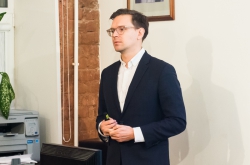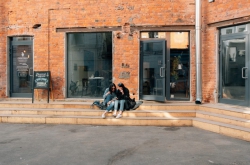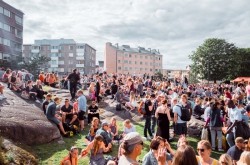What WAAG is and how it operates
WAAG is an organization which consists of research teams that work with both basic-level initiatives and institutional partners all across Europe. At the Smart City laboratory, we conduct many projects for the purpose of giving citizens more information about the state of environment and showing them the ways to interact with new technologies used in cities. We do this with the help of local instruments and simple devices.
Technology as a “black box”
Many modern technologies are, in a sense, “black boxes”. People use them for something, input data, and then poof! – they get a result. We believe this approach to be wrong. One of WAAG’s most important goals is to help people to understand how technology works.
We all hear a lot about such things as artificial intelligence and neural networks. Still, specialists in these fields mostly say things like “Don’t trouble yourself with how it actually works, you don’t need that. Just listen to us and we’ll provide you with the results you want” to the wider audience.We agree that such technologies are indeed complex, but we also believe that it is necessary to at least explain how one can apply them. What is more, there are lots of questions that have to do with ethics: are these technologies really necessary, what is to be done with the data they offer, what are the prospects for its use, and how will it help from the sociocultural standpoint?

At WAAG, we conduct a whole range of public research that focuses on tasks existing at the intersection of science, technology and art. We believe that it’s most important to develop in an interdisciplinary manner: combine different competencies and involve experts from multiple fields. We also invite people to come to our laboratories and learn how different technologies work. For instance, at our microbiology lab one can learn how DNA is analyzed and what data can be derived from it, as well as the ways to use such knowledge.
We collaborate with many developers and designers, and invite specialists from different fields, from mathematicians and data analysts to sociologists and art experts. As a result, we get expert evaluations that allow us to come up with new approaches to developing our projects.
Smart City VS Smart Citizens
In the recent years, the following trend has been becoming all the more popular in relation to the Smart City concept: all technologies can be gathered and used by such major companies as Google. All around the world, the Netherlands included, such companies seek to control data and gather everything that is possible, fix cameras everywhere and track any movement. After that, they want to use their vast capabilities in the field of data analysis in order to process all this information.

At WAAG’s Smart City laboratory, we aim to bring up “smart citizens” who really understand how to apply new technologies in their everyday lives in order to create a better environment. This is why we teach people, and give them instruments that would allow them work with technology on their own, so that it would benefit both themselves and their communities.
Projects and results
In 2014, when we created the Smart City laboratory, we’ve moved beyond words and got out on the streets to ask people about how they and their relatives use new technologies in their work and daily lives. It was then that we also started to involve experts in our project so that they would teach people to apply technologies more effectively and inform them of the related legislation, the issues of urban development and many more. We conducted various small-scale events aimed at teaching people to help forward positive changes in their local communities.
Currently, we are working on a series of projects aimed at controlling the quality of air, noise pollution, and water quality in municipal water supply systems. In every project, it were the citizens who conducted the measurements. We strive to involve them at every stage.

We collaborated with FabLab in Barcelona with a common goal of providing citizens with sensors that would’ve allowed them to conduct measurements independently in particular districts. The first prototypes weren’t very good, especially in comparison with professional equipment. Since then, we’ve done several improvements, which allowed us to conduct the first experiments and look how it works. We tried to improve their quality and also make them affordable, as professional equipment costs too much for common citizens to purchase. Our project's participants didn’t have to pay for the sensors, as we paid for them ourselves.
Affordable solutions for measuring air quality
We conducted our project for measuring air quality on Amsterdam’s most polluted streets. The project involved 45 participants who were interested in bringing positive change to their neighbourhoods. At first, we placed sensors on bikes, but unfortunately, that wasn’t effective. So, we fixed our sensors with special protective casings, and placed them near the professional sensors that belong to governmental structures.
This gave us an opportunity to compare the data, account for any mistakes and adjust cheap makeshift devices. In the end, we started to get good results that we could use for our future tasks.

How exactly can we use such data? This information gives people an insight into such things as the time when it’s best to avoid being out on the streets due to a high concentration of noxious agents. Such projects allow people to make conscious choices and better understand what’s happening around them.
Following the results of our project, we’ve developed a range of tools that can help any person plan and conduct a similar project in their neighborhood. This data is open to anyone who is interested in improving the quality of life on their territory (you can read about it in more detail here). What is more, we post all methods and approaches that we come up with on our website, where one can learn the different ways to plan a project based on what we call co-creation.
Why make data comprehensible to a wider audience
After you learn what exactly interests people, you’ll also have to present your results in an efficient manner. Simply drawing diagrams that would be comprehensible to specialists only would not be enough, as you have to visualize the information in such a way that anyone would understand it. We collaborate with data analysts and designers in order to make our projects comprehensible to a wider audience. What’s more, we gather data and share it on platforms like smartcitizen.me. This lets us combine information from different projects.

How to attract additional attention to a problem
Art projects are one way to do that. For instance, in order to attract attention to the issue of air pollution in Amsterdam, we’ve constructed a “green wall” – an art piece created entirely from vegetation – not far from one of the city’s most polluted streets.
This project was mentioned by several major titles, and after the media focus its attention on the issue, the local authorities also start to forward particular initiatives. At least, this is what happened in our case.
How to fight skepticism
We often face criticism from the professional community: typically, specialists tell us that our sensors are ineffective and can’t give a true picture. We solve this problem by involving a greater amount of participants: the more people do measurements in different locations, the more objective the information is. Thanks to our collaboration with different organizations, we can compare the data we get with the ones received using professional equipment, as well as process the information with the help of specialists and experts from different fields.
After several years, the scientists’ skepticism changed for a desire to cooperate. After they saw that many people take part in our projects, they understood that the data we gather can be used for their research, as well.

Applying WAAG’s experience in Russia
Much as Amsterdam, St. Petersburg is a big city with a dire traffic situation. This is why I believe that air pollution issues are most relevant to its citizens. As this is my first time being in Russia, I don’t know the local political and cultural specifics, and I can’t say for sure whether particular projects can be implemented here. Still, having studied those, you can plan your own projects that make use of our experience and methods, and also try to involve the local authorities in it.
Essential competencies
I received education in the field of political science and management, and I always wanted to learn to manage bigger projects and control the changes they induce. Still, people who work for our team possess competencies from different fields; as I already said, we have people who are versed in data analysis, mathematics, design, IT, social sciences and so on.
My background gave me an opportunity to learn to manage public projects, interact with government entities and know which parties to involve in a particular project. Nevertheless, I depend on a whole range of technical specialists who are essential for bringing our initiatives to life.
It is thanks to us combining our competencies and using knowledge from different sources that we begin to understand what can be done here and now. Projects such as ours are being developed all over the world: in Japan, the USA, and so on. To my mind, the best way to start one of your own is to first look at the existing successful ones, and learn from their experience.
Сoen Bergman is a project lead and fundraiser for the Future Internet Lab of Waag. The expert’s lecture took place at ITMO University with support from the Consulate General of the Netherlands in St. Petersburg. The event was organized by Irina Shmeleva, head of Sustainable Urban Development Lab of ITMO’s Institute of Design & Urban Studies.





